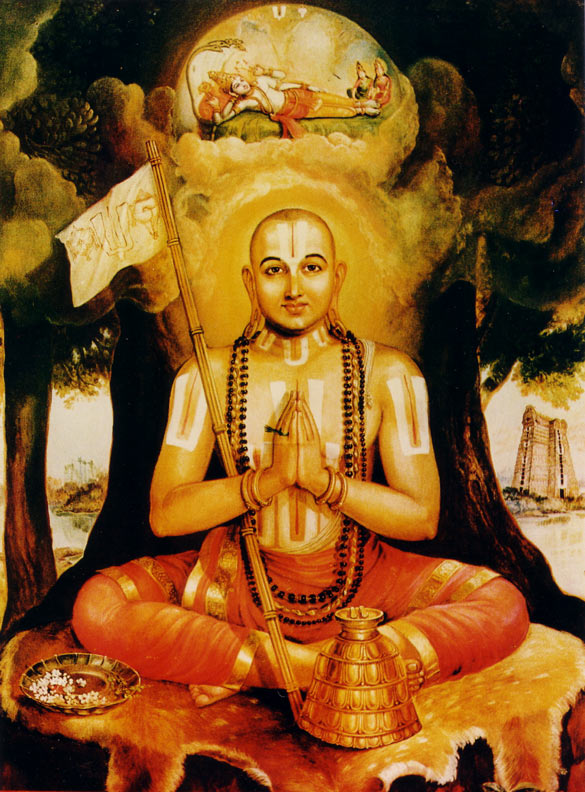Sri Ramanujacharya
In 1017 A.D., when according to astrological calculations, the sun was in the zodiacal sign of Cancer, a saint was born in a Tamil Brahmin family in the village of Sriperumbudur, Tamil Nadu, who rejuvenated the ever existing Sri Sampradaya, that great Saint was Sri Ramanujacharya.
His father was Asuri Keshava Somayaji Deekshitar and mother was Kanthimathi.
He was a Hindu theologian, philosopher, and scriptural exegete, He is also known as Sri Ramanujacharya, Udayavar, Ethirajar (Yatiraja), Emberumannar and Lakshmana Muni.
His advent was at a time when humanity lost its way from the right path and he brought back the faith to people and guided them with absolute selflessness.
From a young age, his intelligence and ability to comprehend highly abstract philosophical points were legendary. He took initiation from Yadavaprakasa, a renowned Advaitic scholar. Though his new guru was highly impressed with his analytical ability, he was quite concerned by how much emphasis Ramanuja placed on bhakti. After frequent clashes over interpretation, Yadavaprakasa decided the young Ramanuja was becoming too much of a threat and plotted a way to kill him. However, Ramanuja’s cousin Govinda Bhatta (a favourite of Yadavaprakasa) discovered the plot and helped him escape. An alternative version is that one of Yadavaprakasa’s students plotted to kill Ramanuja as a means of pleasing their teacher, but Sri Ramanuja escaped in the afore-mentioned manner. Yadavaprakasa was horrified when learnt about the conspiracy. Ramanuja returned to Yadavaprakasa’s tutelage but after another disagreement, Yadavaprakasa asked him to leave.
Ramanuja’s childhood mentor, Kancipurna, suggested he meet with Kancipurna’s own guru, Yamunacharya. After renouncing the life of a house-holder, Ramanuja travelled to Srirangam to meet an aging Yamunacharya, a philosopher of the remergent Vishishtadvaita school of thought. Yamunacharya had died prior to Ramanuja’s arrival. Followers of Ramanuja relate the legend that three fingers of Yamunacharya’s corpse were curled. Ramanuja saw this and understood that Yamunacharya was concerned about three tasks. Ramanuja vowed to complete these–
Write a Visishtadvaita Bhashya for the Brahma Sutras of Vyasa which had previously been taught orally to the disciples of the Visishtadvaita philosophy.
That the name of Paraśara, the author of Vishnu Purana should be perpetuated.
The name of Saint Śaţhakopa should be perpetuated by writing a commentary on the Tiruvoimozhi
Legend goes that on hearing the vow, the three fingers on the corpse straightened.
Ramanuja accepted Yamunacharya as his Manasika Acharya and spent 6 months being introduced to Yamunacharya’s philosophy by his disciple, Mahapurna although he did not formally join the community for another year. Ramanuja’s wife followed very strict brahminical rules of the time and disparaged Mahapurna’s wife as being of lower subcaste. Mahapurna and his wife left Srirangam. Ramanuja realized that his life as a householder was interfering with his philosophical pursuit as he and his wife had differing views. He sent her to her parents’ house and renounced family and became a sanyasin.
Ramanuja started travelling the land, having philosophical debates with the custodians of various Vishnu temples. Many of them, after losing the debates, became his disciples. Ramanuja standardized the liturgy at these temples and increased the standing and the membership of the srivaishnava school of thought. He wrote his books during this time.
Ramanuja, who was a Srivaishnavite, has faced threats from some Shaivite Chola rulers who were religiously followers of Shiva . Ramanuja and a few of his followers moved to the Hoysala kingdom of Jain king Bittideva and queen Shantala Devi in Karnataka.
According to historian Alkandavilli Govindāchārya, Bitti Deva and his chief queen Shantala Devi had a sick daughter. She was possessed by an evil spirit and the Vaishnavite saint Ramanuja is said to have cured her. After this episode it is said that Bitti Deva embraced Vaishnavism. But from his inscriptions in the Hassan district, his daughter by one of his queens called Shantala Devi, died during his reign.
He treated all people as equal without considering their castes. At that time low caste people were prohibited inside the temples. He led the low caste people into the temples in many places. Due to this, he is praised as a “social reformer”.
He is believed to be an avatar ( reincarnation) of “Shesh” on whom the Supreme Lord rests. He propagated Vaishnav belief in the philosophical order of qualified duality (Visheshtadvaita).
There are 74 peeths in this Sampradaya with currently 8 gaddis. One of them is Govardhan Gaddi. It is from this gaddi that Sadguru Sudershanacharyaji maharaj emerged.

